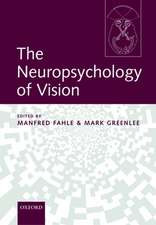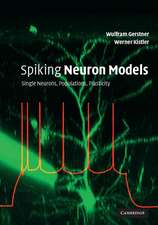Perception-Action Cycle: Models, Architectures, and Hardware: Springer Series in Cognitive and Neural Systems
Editat de Vassilis Cutsuridis, Amir Hussain, John G. Tayloren Limba Engleză Hardback – 14 feb 2011
| Toate formatele și edițiile | Preț | Express |
|---|---|---|
| Paperback (1) | 2111.77 lei 6-8 săpt. | |
| Springer – 23 aug 2016 | 2111.77 lei 6-8 săpt. | |
| Hardback (1) | 2116.19 lei 6-8 săpt. | |
| Springer – 14 feb 2011 | 2116.19 lei 6-8 săpt. |
Preț: 2116.19 lei
Preț vechi: 2580.72 lei
-18% Nou
Puncte Express: 3174
Preț estimativ în valută:
405.06€ • 440.13$ • 340.47£
405.06€ • 440.13$ • 340.47£
Carte tipărită la comandă
Livrare economică 21 aprilie-05 mai
Preluare comenzi: 021 569.72.76
Specificații
ISBN-13: 9781441914514
ISBN-10: 144191451X
Pagini: 500
Ilustrații: XIV, 784 p.
Dimensiuni: 152 x 229 x 50 mm
Greutate: 1.23 kg
Ediția:2011
Editura: Springer
Colecția Springer
Seria Springer Series in Cognitive and Neural Systems
Locul publicării:New York, NY, United States
ISBN-10: 144191451X
Pagini: 500
Ilustrații: XIV, 784 p.
Dimensiuni: 152 x 229 x 50 mm
Greutate: 1.23 kg
Ediția:2011
Editura: Springer
Colecția Springer
Seria Springer Series in Cognitive and Neural Systems
Locul publicării:New York, NY, United States
Public țintă
ResearchCuprins
Preface.- Contents.- Contributors.- Part I. Computational neuroscience models.- Chapter 1. The Role of Attention in Shaping Visual Perceptual Processes John Tsotsos, Albert L. Rothenstein.- Chapter 2. Sensory fusion Mauro Ursino, Elisa Magosso, Cristiano Cuppini.- Chapter 3. Modeling learning and memory consistently from psychology to physiology, Andrew Coward.- Chapter 4. Value maps, drives and emotions Daniel Levine.- Chapter 5. Computational neuroscience models: Error monitoring, conflict resolution and decision making Joshua Brown, William H. Alexander.- Chapter 6. Neural Network Models for Reaching and Dexterous Manipulation in Humans and Anthropomorphic Robotic Systems Rodolphe Gentili, Hyuk Oh, Javier Molina, Jose Contreras-Vidal.- Chapter 7. Schemata learning Jun Tani, Ryunosuke Nishimoto.- Chapter 8. Perception-reason-conceptualization-knowledge representation-reasoning representation-action cycle: The view from the brain John Taylor.- Chapter 9. Consciousness, decision making and neural computation Edmund Rolls.- Chapter 10. A Review of Consciousness Models John G. Taylor.- Part II. Cognitive architectures.- Chapter 11. Vision, attention control and goals creation system, Konstantinos Rapantzikos, Yiannis Avrithis, Stefanos Kolias.- Chapter 12. Semantics extraction from multimedia data: an ontology-based machine learning approach Sergios Petridis, Stavros Perantonis.- Chapter 13. Cognitive algorithms and systems of episodic memory, semantic memory and their learnings Qi Zhang.- Chapter 14. Motivational Processes Within the Perception-Action Cycle Ron Sun, Nick Wilson.- Chapter 15. Error monitoring, conflict resolution and decision making Pedro Lima.- Chapter 16. Developmental Learning of Cooperative Robot Skills: A Hierarchical Multi-Agent Architecture John Karigiannis, Theodoros Rekatsinas, Costas S. Tzafestas.- Chapter 17. Actions & Imagined Actions in Cognitive robots Vishwanathan Mohan, Pietro Morasso, Giorgio Metta, Stathis Kasderidis.- Chapter 18. Cognitive Algorithms and Systems: Reasoning and Knowledge Representation Artur S. d'Avila Garcez, Luis C. Lamb.- Chapter 19. Information theory of decisions and actions Tali Tishby, Daniel Polani.- Chapter 20. Artificial consciousness, Antonio Chella, Riccardo Manzotti.- Part III. Hardware implementations.- Chapter 21. Smart sensor networks Alvin Lim.- Chapter 22. Multisensor Fusion for Low-Power Wireless Microsystems, Alan Murray, Tong Boon Tang.- Chapter 23. Bio-inspired mechatronics and control interfaces. Panagiotis Artemiadis, Kostas Kyriakopoulos.-Subject index.
Textul de pe ultima copertă
The perception-action cycle is the circular flow of information that takes place between the organism and its environment in the course of a sensory-guided sequence of behavior towards a goal. Each action causes changes in the environment that are analyzed bottom-up through the perceptual hierarchy and lead to the processing of further action, and top-down through the executive hierarchy toward motor effectors. These actions cause new changes that are analyzed and lead to new action, and so the cycle continues.
The Perception-Action cycle: Models, Architectures and Hardware book provides focused and easily accessible reviews of various aspects of the perception-action cycle. It is an unparalleled resource of information that will be an invaluable companion to anyone in constructing and developing models, algorithms, and hardware implementations of autonomous machines empowered with cognitive capabilities.
The book is divided into three main parts. In the first part, leading computational neuroscientists present brain-inspired models of perception, attention, cognitive control, decision making, conflict resolution and monitoring, knowledge representation and reasoning, learning and memory, planning and action, and consciousness grounded in experimental data. In the second part, architectures, algorithms, and systems with cognitive capabilities and minimal guidance from the brain are discussed. These architectures, algorithms, and systems are inspired by cognitive science, computer vision, robotics, information theory, machine learning, computer agents, and artificial intelligence. In the third part, the analysis, design, and implementation of hardware systems with robust cognitive abilities from the areas of mechatronics, sensing technology, sensor fusion, smart sensor networks, control rules, controllability, stability, model/knowledge representation, and reasoning are discussed.
About the Editors:
Vassilis Cutsuridis is aSenior Research Scientist at the Center for Memory and Brain at Boston University, Boston, USA.
Amir Hussain is a Reader in Computing Science in the Department of Computing Science and Mathematics at the University of Stirling, UK.
John G. Taylor is an Emeritus Distinguished Professor of Mathematics in the Department of Mathematics at King’s College, London, UK.
The Perception-Action cycle: Models, Architectures and Hardware book provides focused and easily accessible reviews of various aspects of the perception-action cycle. It is an unparalleled resource of information that will be an invaluable companion to anyone in constructing and developing models, algorithms, and hardware implementations of autonomous machines empowered with cognitive capabilities.
The book is divided into three main parts. In the first part, leading computational neuroscientists present brain-inspired models of perception, attention, cognitive control, decision making, conflict resolution and monitoring, knowledge representation and reasoning, learning and memory, planning and action, and consciousness grounded in experimental data. In the second part, architectures, algorithms, and systems with cognitive capabilities and minimal guidance from the brain are discussed. These architectures, algorithms, and systems are inspired by cognitive science, computer vision, robotics, information theory, machine learning, computer agents, and artificial intelligence. In the third part, the analysis, design, and implementation of hardware systems with robust cognitive abilities from the areas of mechatronics, sensing technology, sensor fusion, smart sensor networks, control rules, controllability, stability, model/knowledge representation, and reasoning are discussed.
About the Editors:
Vassilis Cutsuridis is aSenior Research Scientist at the Center for Memory and Brain at Boston University, Boston, USA.
Amir Hussain is a Reader in Computing Science in the Department of Computing Science and Mathematics at the University of Stirling, UK.
John G. Taylor is an Emeritus Distinguished Professor of Mathematics in the Department of Mathematics at King’s College, London, UK.
Caracteristici
Provides focused and easily accessible reviews of various aspects of the perception-action cycle. Unparalleled resource of information that will be an invaluable companion to anyone in constructing and developing models, algorithms and hardware implementations of autonomous machines empowered with cognitive capabilities. Includes supplementary material: sn.pub/extras


























